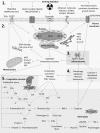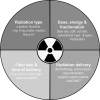Radiation, inflammation and the immune response in cancer
- PMID: 30178305
- PMCID: PMC6267675
- DOI: 10.1007/s00335-018-9777-0
Radiation, inflammation and the immune response in cancer
Abstract
Radiation is an important component of cancer treatment with more than half of all patients receive radiotherapy during their cancer experience. While the impact of radiation on tumour morphology is routinely examined in the pre-clinical and clinical setting, the impact of radiation on the tumour microenvironment and more specifically the inflammatory/immune response is less well characterised. Inflammation is a key contributor to short- and long-term cancer eradication, with significant tumour and normal tissue consequences. Therefore, the role of radiation in modulating the inflammatory response is highly topical given the current wave of targeted and immuno-therapeutic treatments for cancer. This review provides a general overview of how radiation modulates the inflammatory and immune response-(i) how radiation induces the inflammatory/immune system, (ii) the cellular changes that take place, (iii) how radiation dose delivery affects the immune response, and (iv) a discussion on research directions to improve patient survival, reduce side effects, improve quality of life, and reduce financial costs in the immediate future. Harnessing the benefits of radiation on the immune response will enhance its maximal therapeutic benefit and reduce radiation-induced toxicity.
Conflict of interest statement
On behalf of all authors, the corresponding author states that there is no conflict of interest.
Figures




References
-
- Aita VM, Liang XH, Murty VVVS, Pincus DL, Yu W, Cayanis E, Kalachikov S, Gilliam TC, Levine B. Cloning and genomic organization of Beclin 1, a candidate tumor suppressor Ggene on chromosome 17q21. Genomics. 1999;59:59–65. - PubMed
-
- Andrlikova J, Wagner V, Palek V. Investigation of immunoglobulin (IgG, IgA, IgM) levels in the blood serum of uranium miners after higher and lower exposure to ionizing radiation. Strahlentherapie. 1975;149:212–218. - PubMed
-
- Ashwell JD, Jenkins MK, Schwartz RH. Effect of gamma radiation on resting B lymphocytes. II. Functional characterization of the antigen-presentation defect. J Immunol. 1988;141:2536. - PubMed
Publication types
MeSH terms
LinkOut - more resources
Full Text Sources
Other Literature Sources
Molecular Biology Databases

